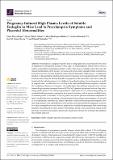Por favor, use este identificador para citar o enlazar a este item:
http://hdl.handle.net/10261/225773COMPARTIR / EXPORTAR:
 SHARE SHARE
 CORE
BASE CORE
BASE
|
|
| Visualizar otros formatos: MARC | Dublin Core | RDF | ORE | MODS | METS | DIDL | DATACITE | |

| Título: | Pregnancy-Induced High Plasma Levels of Soluble Endoglin in Mice Lead to Preeclampsia Symptoms and Placental Abnormalities |
Autor: | Pérez-Roque, L.; Núñez-Gómez, E.; Rodríguez-Barbero, Alicia; Bernabéu, Carmelo CSIC ORCID ; López-Novoa, José M.; Pericacho, Miguel CSIC ORCID CVN | Palabras clave: | Soluble endoglin Placenta Preeclampsia Murine model |
Fecha de publicación: | 26-dic-2020 | Editor: | Multidisciplinary Digital Publishing Institute | Citación: | International Journal of Molecular Sciences 22(1): 165 (2021) | Resumen: | Preeclampsia is a pregnancy-specific disease of high prevalence characterized by the onset of hypertension, among other maternal or fetal signs. Its etiopathogenesis remains elusive, but it is widely accepted that abnormal placentation results in the release of soluble factors that cause the clinical manifestations of the disease. An increased level of soluble endoglin (sEng) in plasma has been proposed to be an early diagnostic and prognostic biomarker of this disease. A pathogenic function of sEng involving hypertension has also been reported in several animal models with high levels of plasma sEng not directly dependent on pregnancy. The aim of this work was to study the functional effect of high plasma levels of sEng in the pathophysiology of preeclampsia in a model of pregnant mice, in which the levels of sEng in the maternal blood during pregnancy replicate the conditions of human preeclampsia. Our results show that wild type pregnant mice carrying human sEng-expressing transgenic fetuses (f<i>WT</i>(<i>hsEng<sup>+</sup></i>)) present high plasma levels of sEng with a timing profile similar to that of human preeclampsia. High plasma levels of human sEng (hsEng) are associated with hypertension, proteinuria, fetal growth restriction, and the release of soluble factors to maternal plasma. In addition, f<i>WT</i>(<i>hsEng<sup>+</sup></i>) mice also present placental alterations comparable to those caused by the poor remodeling of the spiral arteries characteristic of preeclampsia. In vitro and ex vivo experiments, performed in a human trophoblast cell line and human placental explants, show that sEng interferes with trophoblast invasion and the associated pseudovasculogenesis, a process by which cytotrophoblasts switch from an epithelial to an endothelial phenotype, both events being related to remodeling of the spiral arteries. Our findings provide a novel and useful animal model for future research in preeclampsia and reveal a much more relevant role of sEng in preeclampsia than initially proposed. | URI: | http://hdl.handle.net/10261/225773 | DOI: | 10.3390/ijms22010165 | E-ISSN: | 1422-0067 | Identificadores: | doi: 10.3390/ijms22010165 |
| Aparece en las colecciones: | (CIB) Artículos |
Ficheros en este ítem:
| Fichero | Descripción | Tamaño | Formato | |
|---|---|---|---|---|
| ijms-22-00165.pdf | 4,53 MB | Adobe PDF |  Visualizar/Abrir |
CORE Recommender
PubMed Central
Citations
10
checked on 10-abr-2024
SCOPUSTM
Citations
20
checked on 24-abr-2024
WEB OF SCIENCETM
Citations
18
checked on 25-feb-2024
Page view(s)
116
checked on 24-abr-2024
Download(s)
131
checked on 24-abr-2024

